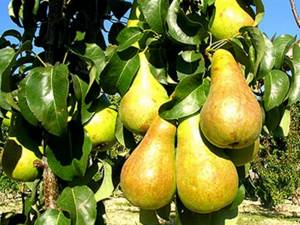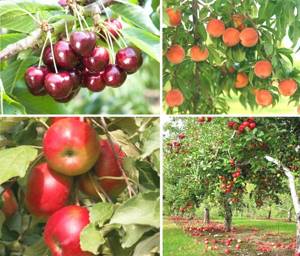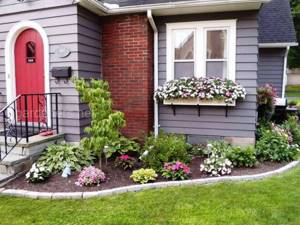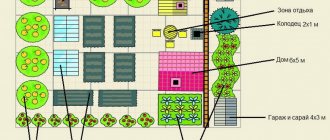Where to begin?
Before deciding on the plants to plant under the windows, you need to think carefully and analyze everything. In this case, it is necessary to take into account factors such as:
1. Which side are the windows on? If the windows are located on the south side, then it is advisable to plant tall trees or shrubs near them to create natural shade in the hot summer heat. And different plants need different amounts of light. Some require direct sun, while others will burn quickly in the sun. So this point should be taken into account so that you do not have to transplant plants from place to place.
2. What kind of soil is on the site. Each plant has soil preferences. Some grow better on black soil, while others need light, loose soil for good development. And don’t forget about the acidity of the soil.
3. Possibility of watering. If moisture-loving plants are planted in the open sun and not watered, something good is unlikely to come out of it. At best, they simply will not grow and develop. At worst, they will simply dry out. And vice versa, if you plant light-loving plants on the north side, where there is practically no sun, they will look very unpresentable and even pitiful.
Boxwood
Boxwoods growing in nature can reach a truly gigantic 6-8 m, while the dimensions of garden boxwoods are much more modest - they rarely grow above 2-3 m. In general, boxwood could be called very unpretentious, if not for one “but” : it does not tolerate frost very well, which means that in winter, even if you want, you will not be able to admire the beauty of this evergreen shrub.
Like many other plants, boxwood does not tolerate prolonged stagnation of water, so if you do not organize good drainage for this shrub, then you will not expect good growth from it. Please note that direct sunlight will negatively affect the health of the plant's foliage.
As for everything else, here boxwood shows itself to be a real Spartan. It easily tolerates short-term waterlogging and drought, does not place great demands on soils, easily tolerates even the most daring hairdressing experiments and grows well in shady areas.
- Boxwood: planting, propagation, care secrets
Even an amateur gardener can grow boxwood on his own plot.
What trees to plant under the windows
Large tall trees are not the best option for planting under windows. With age, their crown grows considerably and can block the entire view and sunlight, which is why the room will be in constant semi-darkness. And the root system of such trees is very powerful and can even damage the foundation of the house.
A good option are ornamental trees that do not reach significant sizes. It could be a rowan tree, the openwork foliage of which is very decorative. In the spring, the rowan tree has beautiful lush blooms, and closer to autumn, bright berries appear on the tree, which decorate the tree all winter. There are many types of dwarf trees. Dwarf birch, linden or ash look very decorative, and their root growth does not grow much and will not cause any harm.
The vinegar tree, or sumac, as it is also called, has very beautiful lacy foliage. During flowering, candle-like inflorescences form on the tree, which remain on the tree almost until next spring, only slightly changing color.
Fruit trees can also be planted under the windows of the house. But at the same time, you need to take into account the fact that ripe apples and pears, falling from the tree, will create noise. And the berries of stone fruit trees attract birds.
What fruit trees can be planted nearby?
Home/Garden and vegetable garden/What fruit trees can be planted nearby?
Everyone wants to have a large, beautiful garden where they can come and enjoy the smell of ripe fruits, taste juicy fruits and walk among the trees. But there is a problem that garden dreamers face - not all plants can be planted with each other. Let's figure out how to solve this problem.
Let me give an example of the most common plants:
1. Apple tree. You should not plant any shrubs with it. Because of its powerful root system, nothing will grow nearby. But raspberries will take root well with it and even contribute to the stability of the apple tree. A tomato would also be a good neighbor. Any stone fruit trees should also be planted nearby, as should hazel, acacia and horse chestnut.
2. Pear accepts proximity only to rowan. Her hated neighbor is the golden currant. Also, you should not plant one pear tree; you need to plant at least 2-3 more trees nearby.
3. Currants. You can plant golden currants nearby, but under no circumstances should you plant raspberries.

4. Cherry does not tolerate proximity to gooseberries and raspberries. Grows well next to cherries and plums.
5. Gooseberry. It gets along well with red currants, but it is better not to plant it with black currants.
6. Plum. You should not plant plums with pears, raspberries, black currants and apple trees. It will take root well with maple, and black elderberry will protect against aphids.
7. Apricot, being a southern plant, does not tolerate proximity to any vegetable; it must be planted extremely consciously.
8. Grapes can grow with pear, Chinese lemongrass, acacia, beans, onions, radishes, and cauliflower.
9. Raspberry is a loner, capable of invading any territory and strangling neighboring low plants. Loves moisture. It should be planted away from other plants.

10. Walnut gets along well with dogwood, sea buckthorn and other medicinal herbs. It will not allow any fruit trees to grow nearby, especially apple trees.
11. Sea buckthorn is selfish. A bad neighbor for everyone except herself.
12. Golden currants will take root next to black currants. An apple tree and a pear tree will be bad neighbors for her.
First of all, you need to make a tree planting plan. All trees must have enough light, nutrients and space.
All plants need the nutrients they need from their environment. They don't have to fight each other for survival.
Some feeds and fertilizers will have a beneficial effect on some plants and a bad effect on others. It is best to distribute the plants in the garden into groups so that the plants do not become irritated by feedings they do not like.

Plants get most of their nutrients from the soil, so it is important that there is enough space in the soil for each plant's roots. Also, due to the fact that plant roots grow throughout their life, it is necessary to calculate the location carefully.
If you approach garden planning with all seriousness, you can get a magnificent garden that will require little time for maintenance and will delight you with its beauty and harvest.
AllaAuthor of the article
Did you like the article?
Share with your friends:
Add a comment
Click to cancel reply.
Coniferous plants
A flower bed with coniferous plants fits very well near the windows of the house. What to plant under the window of a house from conifers? Their variety is so great that you can easily select options for almost any conditions. Tall spruces, junipers and thujas will be an excellent background for lower or creeping species.
According to the color of the needles, plants can be of all shades of green and even yellow and blue, so you can create very bright compositions. The shape of conifers can also be any. With age, as the plants grow, the picture will take on a stunning appearance. In addition to being decorative, coniferous plants will also create a cozy atmosphere, and the air will be saturated with coniferous aromas.
Rosary under the windows of the house
Roses planted under the windows of the house will not only delight you with magnificent, abundant and long-lasting flowering, but will also fill the area with an incredible aroma. There are a very large number of varieties of roses. Flowers can come in a variety of shades, shapes and sizes.
Bushes can be climbing and reach up to 350-400 centimeters in length. Standard roses form lush caps of flowers, which are located at a height of a meter or more above the ground. Scrubs, park or English varieties of roses grow in large bushes that are literally strewn with flowers and bloom almost continuously throughout the summer. Compact miniature and border varieties are perfect for the foreground of a flower bed.
Ornamental shrubs
What to plant under the window of a house from ornamental shrubs? With their help, you can create magnificent corners under the windows of your home that are not only colorful, but also cozy. Flowering bushes such as lilac, jasmine, azaleas, scumpia, spirea, weigela will create a fabulous atmosphere during flowering. And shrubs with decorative leaves will delight you throughout the year.
The barberries alone are worth it. They can have green, red, yellow, orange, brown, brown and variegated leaves. In addition, they can be quite tall, sloping, erect or dwarf, which grow neat round crowns. Barberries are easy to trim and can be easily shaped. At the end of summer, bright red berries appear on the bushes, which look beautiful in winter.
A decorative deciduous bush of viburnum or elderberry will fit well under the windows of the house. The fruits of these shrubs are not only very decorative, but also useful. Hydrangea has large inflorescences and will become a real decoration of the local area. Its color range is very diverse, so you can choose shades that fit perfectly into the overall exterior.
Japanese quince is a very compact ornamental shrub that will delight you with bright flowering in the spring. Over time, yellow-red fruits will appear on the bush, which look beautiful and are great for aromatic jam.
Rhododendron katevbinsky
Almost all rhododendrons easily tolerate shading, which makes them suitable for growing in tree trunks. Novice gardeners try to avoid this plant, believing that the shrub brought to us from the east will not be able to survive the harsh winters of the middle zone.
Most rhododendrons are truly heat-loving, but there are also those among them that can withstand frosts down to –30°C without any problems. These also include representatives of the Katevbinsky rhododendron group, which are popular among us.
The large bell flowers of this plant will decorate your garden from late May to early June, and the leathery and shiny evergreen leaves will refresh the composition in the autumn-winter period.
Frost-resistant varieties and hybrids of rhododendron: Roseum Elegance, White Lights, Rosie Lights, etc.
- Planting rhododendron in the country: tips for beginners
Everything you wanted to know about caring for rhododendron on your site, but were embarrassed to ask.
What else can you plant?
You can plant absolutely any flowers you like under the windows. Irises, lilies, daisies, poppies and many other plants. If the windows of the house are located on the north side, you can make a beautiful flowerbed of hostas under them. There are many varieties of it, and the leaves can be of very diverse and interesting colors.
The sizes of hosta bushes can also be different; there are dwarf varieties and large ones. You can dilute the colorful hosta greens with heuchera or brunner.
To make the flower beds under the windows delightful from the very early spring, you can plant bulbous primroses such as tulips, crocuses, muscari, daffodils and others.
There are a lot of options for designing the area under the windows of the house. It is not necessary to plant plants of the same type; you can combine them perfectly. For example, conifers with roses look great. It all depends solely on personal preferences and wishes. You just need to think carefully about everything before buying plants and planting them, taking into account what they will be like in a few years.

Remember about drainage and communications!
Even if you are going to use moisture-loving plants in your flower garden, before you start arranging a flower bed near the wall of the house, first of all make sure that water flowing from the roof cannot get into the flower bed and will not harm the plantings.
Do not forget that plants should be planted in the immediate vicinity of the house so that they cannot damage the foundation or communications connected to the house. Tall crops with a spreading crown should not be planted directly under windows. Firstly, this can lead to disruption of insolation, and secondly, by placing such plants on the north side of the building, you will increase the risk of mold development.
Arrange a beautiful flowering flowerbed under your window, and from the very morning you will receive a boost of energy for the whole day!











